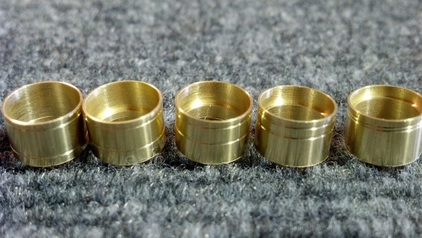 Picking up where I left off in part II, let's explore Impedance and Mouthpiece Gap adjustments available within the AGR System. Some of you have read my previous entries on Mouthpiece Gap, but if you missed them it may be helpful to check out the following pages on my website and blog: Mouthpiece Gap I Mouthpiece Gap II Mouthpiece Gap Solutions Survey of 31 Mouthpieces (Gap) A quick review of my research and development on the subject of mouthpiece gap reveals the following discoveries and information assets: - Recognizing venturi and gap as crucial components of custom fitting trumpets, I have incorporated these into my line of instruments since 2001. - Having measured and adjusted gap with various client mouthpiece variations over one thousand times, my notes on client preferences and experiences have been the basis of my current recommendations on gap, venturi and the AGR design. - My system of measuring venturi and gap with custom tools and inserts is available to all players today allowing anyone to fine tune gap without the need to retrofit the instrument. - The Gap Solution Kit introduced last summer has been very well received with almost 200 sets sold to individual players. The feedback received from these clients has influenced the final design of the AGR System. - The new 5MM Modular Mouthpiece System was designed to offer a gap solution utilizing a series of shanks of various lengths. This allows the player to choose the correct shank length to optimize gap and impedance on any horn. It may be obvious that I've been slightly obsessed with gap for some time. But in reality, this is something I never think about in my own playing. I have used a zero gap setting for so many years that I truly never think about this variable and this is my goal for my clients as well. There is freedom in finding that balance between slotting and flexibility, which rarely occurs without some exploration and effort. But once you find it, accuracy, intonation, wide intervals and flow remain consistent as long as your setup doesn't change. So the first goal is to find optimum gap and the second is to keep this setting with all mouthpieces and instruments. This may sound simple, but achieving these goals can drive some players crazy! And this is why I developed the Adjustable Gap Receiver. Okay, some of you didn't read my previous entries on gap so here's a quick review. If you ignore gap entirely, you are missing out on some serious advantages that people around you may be experiencing. These include greater flexibility and slotting especially in the extreme edges of your range. Can you easily slur from low C to high C? How about from pedal C to double high C? If so, then your setup may be close to optimum. But if you hit lots of notes between wide interval slurs, this could be a sign that your gap setting does not coincide with your style of aperture control and embouchure. Locking in too hard on the partials below your target is a sign that you have too much gap. Sliding around and missing the note altogether is a sign that you need more gap. Remember, gap is the distance from the end of the mouthpiece shank to the beginning of the leadpipe. This space is a wider diameter than the mouthpiece and leadpipe edges, which creates a variance in impedance and in turn changes the feel of flexibility and slotting. I personally use zero gap, meaning there is no space between my mouthpiece and leadpipe on my Summit One to intentionally remove this impedance change. However, the vast majority of brass players are accustomed to varying degrees of impedance variation due to gap so finding the balance that works best for you should be the primary goal. The AGR Inserts are individually numbered and precision machined to create a complete series of gap options. These are logically numbered based on their real measurements. Insert #2 offers a theoretical gap of .02" or two one hundredths of an inch. Likewise, #4 creates .04" gap, #6 = .06" and so on. The largest insert is #18, which creates the most gap, but due to the constraints of the system it measures a maximum gap of more than .180". This is the only AGR Insert that does not follow the previous rule only because there is no more insert wall to remove at this point as it approaches the other end of the tube length. This insert is included with the AGR for clients using Schilke mouthpieces as these tend to have a longer than usual shank length. Understanding how to "read" the lines on the AGR Inserts is important when experimenting with various gap settings. I have labeled each Insert with two small lines on the outside diameter that directly represent the shoulder relief on the inside of the tube. The first line represents the theoretical length of the mouthpiece shank end. The second line represents gap distance. For example, the smallest insert is #1, which has two lines only .01" apart. This represents the theoretical gap created as the inside shoulder has been reduced by .01". This may be confirmed with a caliper, but the easiest technique is to line all of your inserts in a row from largest to smallest as in the photo above. Keeping your inserts in order speeds up the process by which you experiment with them. I highly recommend labeling each insert with a colored dot or name written in permanent fine tip marker. If you find that the #4 insert is preferable when playing your Monette B2, then write B2 on that insert. Do the same for each mouthpiece you use regularly so that you no longer need to remember the insert numbers. In the case of using many mouthpieces, it may be necessary to number the inserts and keep a record of your preferences in a simple chart. For those of you using the 5MM Modular Mouthpiece System, all of this is simplified so long as your various backbores are ordered in the same length. I'll explain more about the 5MM and how it was designed to work with the AGR in a future entry. For your reference, I have found that Inserts 2-5 work well with Monette mouthpieces, 8-14 with Bach and Yamaha, 16-18 with Schilke and 1-18 with the 5MM System. Included with every AGR Retrofit Kit and Summit trumpet are five inserts; #18, #16, #12, #8 and #4. The photo above shows the inserts arranged in the same order. You may fine tune your gap/impedance setting with any custom size available for at minimal cost. In my next blog entry, we will explore changing air flow and Venturi with the AGR...
0 Comments
Your comment will be posted after it is approved.
Leave a Reply. |
Jason Harrelson
Inventor, Musician, Educator and Founder of Harrelson Trumpets, Trumpet Momentum and Harrelson Momentum. Archives
July 2024
|


 RSS Feed
RSS Feed
